Flag of South Vietnam
The flag of South Vietnam served as national flag of the former State of Vietnam, and its successor, the Republic of Vietnam from 1949 to 1975. The flag is popular amongst western-aligned overseas Vietnamese communities but is banned in the Socialist Republic of Vietnam. It consists of a yellow background with three red horizontal stripes through the middle.
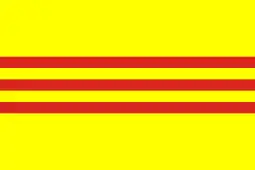 | |
| Name | Heritage and Freedom Flag (Lá cờ Tự do và Di sản) Yellow Flag with Three Red Stripes (Cờ vàng ba sọc đỏ) |
|---|---|
| Use | Civil and state flag |
| Proportion | 2:3 |
| Adopted | 1949 to 1975 |
| Design | A yellow flag with three horizontal red stripes. |
| Designed by | Lê Văn Đệ |
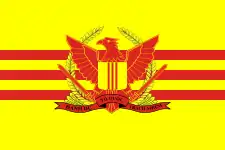 Variant flag of Republic of Vietnam | |
| Name | Flag of the RVNMF |
| Use | War flag |
| Design | A yellow flag with three red stripes, and the emblem of RVNMF (red eagle) in the middle. |
| Designed by | Design is a variant of the flag of South Vietnam. |
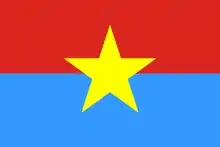 Flag of the Republic of South Vietnam (1969–1976) | |
| Name | Flag of the Viet Cong |
| Use | State and war flag, civil and state ensign |
| Design | A large yellow star centered on a bi-colored red and azure field. |
| Designed by | Huỳnh Tấn Phát |
The flag was originally inspired by Emperor Thành Thái in 1890,[1] and was revived by Lê Văn Đệ and Emperor Bảo Đại, respectively, in 1948.[2] The flag consists of a yellow field and three horizontal red stripes, and can be explained as either emblematic of the common blood running through northern, central, and southern Vietnam.
Although South Vietnam ceased to exist in 1975, the flag still finds use among private citizens in other countries and is still shown and used overseas by some Vietnamese emigrés, particularly those residing in North America and Australia. Former South Vietnamese citizens who fled Vietnam in the late 1970s and 1980s as Boat People, consider the current Vietnamese flag offensive and even sometimes even triggering as they see it as a symbol of an administration that had persecuted them during and after the war. [3] From June 2002 onward, in the United States, at least 13 U.S. state governments, seven counties, and 85 cities in 20 states have adopted resolutions recognizing the yellow flag as the "Vietnamese Heritage and Freedom Flag." [4][5][6][7]
History
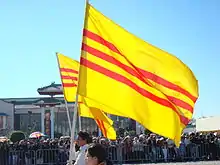
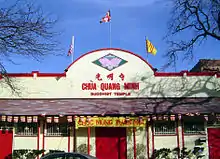
During the reign of Emperor Gia Long (1802–1820), the yellow flag was also used as the symbol of the Empire of Vietnam. This was continued as the Emperor's flag when the Court of Hue became a French protectorate.
In 1890, the Emperor Thành Thái issued a decree, adopting the yellow flag with three red stripes for the first time as the national flag (Đại Nam (National Flag) 1890-1920). Some claim this flag (called The Yellow Flag for short) is the first true "national flag" of the Vietnamese people for it reflects the aspiration and hope of the people, not just the emperors, for independence and unification of the Viet nation.[2][8][9] The meaning and design of Thành Thái's flag and artist Lê Văn Đệ's flag are almost the same – gold background with 3 horizontal red stripes across the center representing Vietnam's 3 geographic & cultural regions (Northern, Central, and Southern), but Thành Thái's flag had stripes which are lighter red and wider.[2]
After the deportation and exile of the Emperors Thành Thái and Duy Tân, the new pro-French puppet king Khải Định chose to change the imperial flag, replacing the three strips which signified the three regions of Vietnam (North, Central, and South) with a single horizontal band of red. Formally known as the "Long Tinh Kỳ", the flag was the official flag of the Nguyễn Court.
In 1945 with the French ousted by Japan, Prime Minister Trần Trọng Kim of the newly restored Empire of Vietnam adopted another variant of the yellow flag. It included three red bands but the middle band was broken to form the Quẻ Ly Flag. Derived from the trigrams, Quẻ Ly is the third of the Bát Quái (the Eight Trigrams – Ba gua): Càn (乾), Đoài (兌), Ly (離), Chấn (震), Tốn (巽), Khâm (坎), Cấn (艮), Khôn (坤). It was chosen to symbolize the sun, fire, light, and civilization. And most importantly, it represents the southern lands under the "Later Heaven" order, that is Vietnam. This flag was used briefly from June to August 1945 when Emperor Bảo Đại abdicated.
On 2 June 1948, the Chief of the Provisional Central Government of Vietnam, Brigadier General Nguyen Van Xuan, signed the decree with the specifications for the Vietnamese National Flag as follows: "The national emblem is a flag of yellow background, the height of which is equal to two-thirds of its width. In the middle of the flag and along its entire width, there are three horizontal red bands. Each band has a height equal to one-fifteenth of the width. These three red bands are separated from one another by a space of the band's height." When the former Emperor Bảo Đại was made chief of state in 1949, this design was adopted as the flag of the State of Vietnam.
The three red bands have the divination sign of Quẻ Càn, the first of the Eight Trigrams mentioned above. Quẻ Càn represents heaven. Based on the traditional worldview of the Vietnamese people, Quẻ Càn also denotes the South (as of the "Earlier Heaven" order), the Vietnamese Nation, Vietnamese people, and the people's power. Another interpretation places the three red bands as symbols of the three regions of Vietnam: North, Central, and South.
With the foundation of the republic in 1955, the flag was adopted by the successor state, the Republic of Vietnam (more commonly known as South Vietnam). It was the national flag for the entire duration of that state's existence (1955–1975) from the First Republic to the Second Republic. With the capitulation of Saigon on April 30, 1975, the Republic of Vietnam came to an end and the flag ceased to exist as a state symbol. Afterwards, it has been adopted by many in the Vietnamese diaspora to symbolically distance themselves from the Communist government and continues to be used either as an alternative symbol for ethnic unity or as a protest tool against the current government.
Political significance
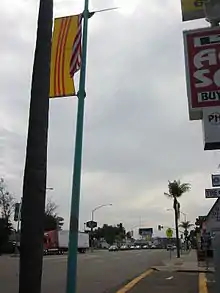
The flag of the former South Vietnam (also used under Emperor Thành Thái) is popular with the case of Vietnamese Americans, Vietnamese Australians, and other Vietnamese around the world who fled Vietnam after the war, who call it the "Vietnamese Heritage and Freedom Flag.".
In the United States, few Vietnamese immigrants use the current flag of Vietnam,[10] which many of them consider offensive. Instead, they prefer to use the flag of South Vietnam in its place. The same is true for Vietnamese Canadians in Canada, Vietnamese Germans in western Germany, for Vietnamese in the Netherlands, France, Norway and the United Kingdom, and for Vietnamese Australians in Australia.
Official recognition
- In 1965, the South Vietnamese flag's design was incorporated into the Vietnam Service Medal which was created by President Lyndon Johnson and designed by Thomas Hudson Jones and Mercedes Lee.
- In 2003, the Virginian state government rejected a bill that would've recognized the South Vietnamese flag.[11]
- From 2002 onward, the lobbying efforts of Vietnamese Americans resulted in the state governments of Virginia, Hawaii, Georgia, Colorado, Florida, Texas, Oklahoma,[6] Louisiana,[12] Ohio,[13] California,[14] Missouri,[15] Pennsylvania,[16] and Michigan[17] recognizing it as the symbol of the Vietnamese American Community. Also, at least 15 counties and 85 cities in 20 states have also adopted similar resolutions.[5][7]
- From 2015 onward in Australia, the City Councils of Maribyrnong,[18] Greater Dandenong,[19] Yarra,[20] Fairfield,[21] Port Adelaide Enfield,[22] and Brimbank,[23] respectively, have passed motions recognizing the "Co Vang" Vietnamese Heritage Flag.
Controversies
- When a Vietnamese American video tape store owner displayed the current flag of Vietnam and a photo of Ho Chi Minh in front of his store in Westminster, California, in 1999, a month-long protest against it climaxed when 15,000 people held a candlelight vigil one night, sparking the Hitek Incident (Hitek was the name of the store).[24]
- A faux pas by the United States Postal Service in using the current Vietnamese flag in a brochure to represent the Vietnamese American community that it serves caused outrage among Vietnamese Americans and resulted in an apology.
- In 2004, many Vietnamese American students at the California State University, Fullerton threatened to walk out on their graduation ceremony when the university chose to use the current flag of Vietnam to represent its Vietnamese students. The Vietnamese American students demanded that the university use the former flag of South Vietnam instead. This resulted in the university scrapping all foreign flags for the ceremony.[25]
- In 2006, Vietnamese-American students at the University of Texas at Arlington protested against the use of the Vietnamese flag in the Hall of Flags in Nedderman Hall and the exclusion of the South Vietnamese flag at a cultural diversity show during International Week.[26] After weeks of protests, the university decided to scrap all flags from the display.
- During World Youth Day 2008 in Sydney, tensions flared between the 800 Vietnamese pilgrims who used the flag of the Socialist Republic of Vietnam and the 2300 Vietnamese Australians pilgrims who used the Republic of Vietnam flag.[27]
- In 2008, many protested against Nguoi Viet Daily News, a Vietnamese-language newspaper in Orange County, California, for publishing a photograph of an art installation[28] depicting a foot spa bearing the colors of the flag.[29]
- In October 2014, the Vietnamese Student Association chapter at the University of Arizona discovered that the University had removed the South Vietnamese flag from the campus bookstore's Flag Display (which includes flags from all over the world to celebrate the diversity found among students). Afterwards, the VSA chapter launched an online petition in protest to the decision.[30] The University then responded and explained that the removal was due to a misunderstanding amongst the staff. It then apologized and promised to reinstall the flag afterwards.
- During the 2021 storming of the United States Capitol, many South Vietnamese flags were seen in the crowd of rioters.[31][32] There were mixed reactions among Vietnamese Americans in Southern California.[33] Forty-five Vietnamese American community advocates, politicians, and business leaders signed a statement condemning the use of the South Vietnamese flag in this context,[34] and various Vietnamese American government officials also wrote statements opposing it.[35]
Colors and dimensions
.svg.png.webp)
The colors approximation is listed below:[2]
Color scheme |
Yellow | Red |
|---|---|---|
| CMYK | 0, 0, 100, 0 | 0, 73, 78, 6 |
| RGB | 255, 255, 0 | 239, 65, 53 |
| Hexadecimal | #FFFF00 | #EF4135 |
See also
References
- Dang, Thanh Thuy Vo (2008). Anticommunism as cultural praxis: South Vietnam, War, and Refugee Memories in the Vietnamese American Community. San Diego, California. ISBN 9780549560173. Retrieved 2011-03-28.
- Chế độ Cộng sản Việt Nam (2013-06-04). "Tìm lại những lá cờ hoàng gia xưa ở Việt Nam". Kỷ vật lịch sử. Cuộc vận động Sưu tầm và Tuyên truyền Kỷ vật lịch sử Công an Nhân dân. Archived from the original on 2014-10-06. Retrieved 2014-09-25.
- "The Other Vietnamese Flag - Asian Recipes". asiarecipe.com.
- Do, Anh Do, By Anh. "Nearly 40 years after war's end, flag of South Vietnam endures". latimes.com.
- States and Localities Recognizing the Vietnamese Freedom and Heritage Flag Archived May 29, 2009, at the Wayback Machine
- Quoc Ky Vietnam: A Map and List of state and city legislation recognizing the Freedom and Heritage Flag Retrieved 2013-8-7
- Vietnamese American Television: List of states and cities that recognize the Vietnam Freedom and Heritage Flag Archived 2015-10-18 at the Wayback Machine Retrieved 2013-8-7
- Cahoon, Ben. "Vietnam". www.worldstatesmen.org.
- The National Flag of Viet Nam: Its Origin and Legitimacy or in Vietbao.com Archived 2007-05-13 at the Wayback Machine or in PDFArchived May 12, 2005, at the Wayback Machine
- Christian Collet, Pei-te Lien (2009). The transnational politics of Asian Americans. Temple University Press. p. 67. ISBN 9781592138623.
- "Va. Bill Promoting S. Vietnam Flag Dies". AP via Lycos.com. February 17, 2003.
- Louisiana Legislature. "RS 49:153.3". Retrieved 2009-06-01.
- Ohio Legislature, 126 SB 114
- Office of the Governor, Executive Order S-14-06
- Missouri Legislature, HCR0026I
- Pennsylvania Legislature, HR 863
- Michigan Legislature, Resolution No. SR148 and HR16
- "Maribyrnong to allow flying of former South Vietnam flag". News. Retrieved 2015-12-15.
- "Recognition of the Vietnamese Heritage Flag by Greater Dandenong City Council". SBS Your Language. Retrieved 2015-12-15.
- "Civic Flag Policy" (PDF). Retrieved 2019-04-26.
- "Acknowledgement of heritage and culture". Retrieved 2019-04-26.
- "Council Meeting Minutes" (PDF). Retrieved 2019-04-26.
- Papworth, Tate. "Vietnamese cheer flag victory". Star Weekly. Retrieved 2019-04-26.
- KOCE, Saigon, USA, 2004
- College Defuses Flag Protest, Los Angeles Times, May 12, 2004
- A.J. Eaton (2006-04-20). "Protests will last until finals week". The Shorthorn Online. Retrieved 2008-04-30.
- David Ramli (2008-07-15). "Vietnamese Flag Choice Sparks Ideological Debate". Special Broadcasting Service. Retrieved 2008-07-28.
- "art installation". Archived from the original on 2008-12-19. Retrieved 2008-11-12.
- My-Thuan Tran (2008-02-12). "Vietnamese Americans protest published photo". Los Angeles Times. Retrieved 2008-11-11.
- "HELP GET OUR FLAG BACK!". 2014-10-02. Retrieved 2016-08-19.
- "Alarm, Confusion and Embarrassment Over Southeast Asian Symbols at Pro-Trump Riot". Vice News. Retrieved 2021-01-10.
- Rosenberg, Matthew; Tiefenthäler, Ainara (January 13, 2021). "Decoding the Far-Right Symbols at the Capitol Riot". The New York Times. Retrieved January 13, 2021.
- "Mang cờ VNCH đi biểu tình ở Quốc Hội Mỹ: Đồng tình hay phản đối?" [Bringing the Republic of Vietnam flag to the Capitol protest: Agree or disagree?]. Nguoi Viet Daily News (in Vietnamese). Westminster, California. January 12, 2021. Retrieved January 13, 2021.
- "Những Tổ Chức Người Mỹ Gốc Việt Lên Án Việc Đánh Phá Nền Dân Chủ Hoa Kỳ" [Vietnamese-American Organizations Condemn Raid on American Democracy]. Việt Báo (in Vietnamese). Garden Grove, California. January 10, 2021. Retrieved January 13, 2021.
- "Người Việt Nghĩ Gì Về Biến Cố Bạo Động Chiếm Quốc Hội Hoa Kỳ Và Sự Tham Dự Của Lá Cờ Vàng?" [How do Vietnamese People View the Invasion of the United States Capitol and Appearance of the Yellow Flag?]. Việt Báo (in Vietnamese). Garden Grove, California. January 12, 2021. Retrieved January 13, 2021.
External links
- Early Vietnamese flags
- Flag of the Republic of Vietnam (South Vietnam)
- The National Flag of Free Vietnam
- CNN article on the Vietnamese-American community adoption of the flag of former South Vietnam as their emblem
- The National Flag of Viet Nam: Its Origin and Legitimacy or in Vietbao.com or in PDF
- (in Vietnamese) Chiến Dịch Vinh Danh Cờ Vàng Ba Sọc Đỏ